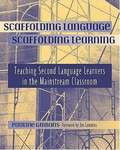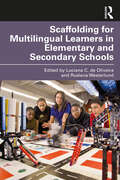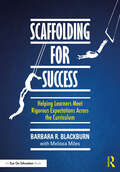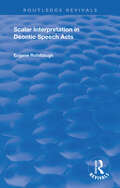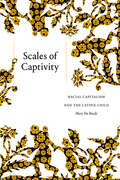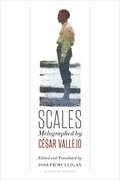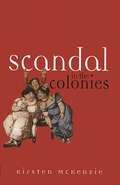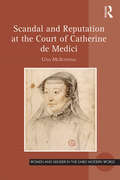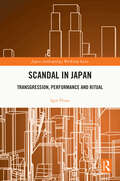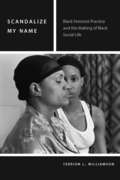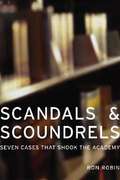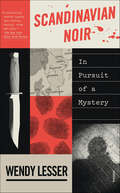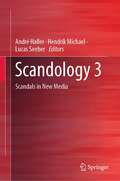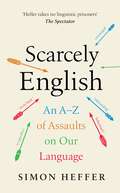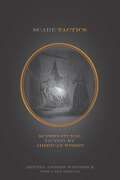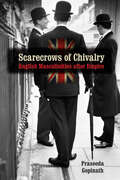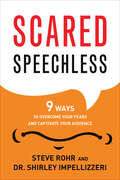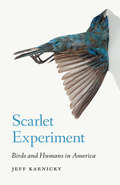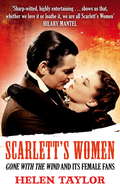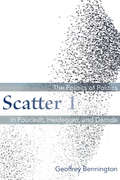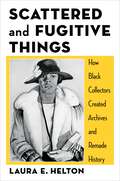- Table View
- List View
Scaffolding Language, Scaffolding Learning: Teaching Second Language Learners in the Mainstream Classroom
by Jim Cummins Pauline GibbonsHow does a mainstream elementary classroom teacher with little or no specialized ESL training meet the challenge of teaching linguistically diverse students? Pauline Gibbons suggests how: integrate the teaching of English with the content areas of the regular curriculum. What's more, she shows how in this practical resource book. Gibbons begins with a strong theoretical underpinning for her practice, drawing on a functional model of language, sociocultural theories of learning, and current research on second-language development. After supporting her view that the regular curriculum offers the best language-learning environment for young ESL students, Gibbons demonstrates the ways in which content areas provide a context for the teaching of English, from speaking and listening to reading and writing. These in turn are treated not as discrete skills, but as ones that can also be integrated in the learning of diverse subjects. Gibbons illustrates this with a wide range of teaching and learning activities across the curriculum, supplemented with programming and assessment formats and checklists. Language learning is not a simple linear process, but involves the ongoing development of skills for a range of purposes. Gibbons sees this development as largely the result of the social contexts and interactions in which learning occurs. By focusing on the ways in which teachers can "scaffold" language and learning in the content areas, she takes a holistic approach-one that appreciates the struggle of students learning a new language, while simultaneously developing subject knowledge in it, and the challenge for teachers to address these needs. Given today's culturally and linguistically diverse classrooms, ESL students can no longer be thought of as a group apart from the mainstream-they are. the mainstream. This book describes the ways to ensure that ESL learners become full members of the school community with the language and content skills they need for success.
Scaffolding for Multilingual Learners in Elementary and Secondary Schools
by Luciana C. de Oliveira Ruslana WesterlundThis insightful and timely volume addresses how scaffolding can be used to support multilingual learners to amplify their opportunities for learning. As a dynamic educational process, scaffolding facilitates responsive and adaptive teaching and learning; addresses students’ needs; increases student autonomy; and promotes adaptive, high-level learning without simplifying instruction. Section I covers the theoretical grounding and reconceptualizations of scaffolding. Section II offers concrete examples and case studies from varied classroom contexts. Section III provides a window into professional development to discuss the work of pre-service and in-service teachers, and how they develop their understandings and practices of teaching multilingual learners. Contributors address diverse topics, including translanguaging in the classroom, scaffolding as a tool for equitable teaching, virtual learning, as well learning in dual language and content area classrooms. Featuring examples from teacher education programs as well as principles for design of educative curriculum materials, this book is ideal for pre-service teachers and students in TESOL, applied linguistics, and language education.
Scaffolding for Success: Helping Learners Meet Rigorous Expectations Across the Curriculum
by Barbara R. BlackburnSupport and scaffolding are critical for moving students to higher levels of learning. But how do we ensure we’re giving the “right” work and not just extra work? Barbara R. Blackburn has the answers in this important new book. She provides a plethora of strategies for helping students create meaning and become more independent so they can truly learn at rigorous levels.First, she examines the basics of rigor and scaffolding and uncovers the role of planning in scaffolding, including the difference between acceleration and remediation and examples of differentiating instruction with scaffolding. Then she demonstrates a variety of ways to add scaffolding into classroom discourse, vocabulary, comprehension, and writing across the curriculum. Ideas and strategies are provided for different subject areas and levels, so you can easily apply them to your own setting. And finally, she shows the roles of formative assessment and social emotional learning in scaffolding.With this practical book, you’ll have a toolkit of great ideas at your disposal as you foster a learning environment of high expectations and success.
Scalar Interpretation in Deontic Speech Acts
by Eugene RohrbaughFirst Published in 1997. As the title suggests, this book is about the interpretation of scalar terms in commands and permission sentences. Why limit our study of the semantics of this class of lexical items to commands and permissions? In short, because there is more than enough to say about this mere subset of environments. Add to that the fact that reams have been written about scalar implicature in assertions, whereas relatively little has been said about the use of scalar terms in other types of illocutionary acts.
Scales of Captivity: Racial Capitalism and the Latinx Child
by Mary Pat BradyIn Scales of Captivity, Mary Pat Brady traces the figure of the captive or cast-off child in Latinx and Chicanx literature and art between chattel slavery’s final years and the mass deportations of the twenty-first century. She shows how Latinx expressive practices expose how every rescaling of economic and military power requires new modalities of capture, new ways to bracket and hedge life. Through readings of novels by Helena María Viramontes, Oscar Casares, Lorraine López, Maceo Montoya, Reyna Grande, Daniel Peña, and others, Brady illustrates how submerged captivities reveal the way mechanisms of constraint such as deportability ground institutional forms of carceral modernity and how such practices scale relations by naturalizing the logic of scalar hierarchies underpinning racial capitalism. By showing how representations of the captive child critique the entrenched logic undergirding colonial power, Brady challenges racialized modes of citizenship while offering visions for living beyond borders.
Scales: Melographed by César Vallejo
by César Vallejo Joseph MulliganFirst published in 1923, just before César Vallejo left Peru for France, Scales combines prose poems with short stories in a collection that exhibits all the exuberance of the author’s early experimentalism. A follow-up to Vallejo’s better-known work, Trilce, this radical collection shattered many aesthetic notions prevailing in Latin America and Europe. Intermingling romantic, symbolist, and avant-garde traditions, Scales is a poetic upending of prose narrative that blends Vallejo’s intercontinental literary awareness with his commitment to political transformation. Written in part from Trujillo Central Jail, where Vallejo would endure some of the most terrifying moments of his life, Scales is also a testament of anguish and desperation, a series of meditations on justice and freedom, an exploration of the fantastic, and a confrontation with the threat of madness. Edited and translated from the Castilian by the scholar Joseph Mulligan, this first complete English translation, published here in bilingual format and accompanied by extensive archival documentation related to Vallejo’s incarceration, this volume gives unprecedented access to one of the most inventive practitioners of Latin American literature in the twentieth century.
Scandal In The Colonies
by McKenzie, KirstenIn 1830s Sydney, a visiting aristocrat, Viscount Lascelles, is exposed as a former convict. In Cape Town, during the same decade, veiled accusations of incest and murmurs about a concealed pregnancy surround the family of the Chief Justice, Sir John Wylde. In these British colonies, the divide between the respectable and the disreputable is not as vast as might first appear. Rumour and hearsay muddy the lines between public and private worlds, and ensure that secret transgressions do not remain secret for very long. Scandal in the Colonies explores how colonial societies offered European settlers the opportunity to invent new identities, an opportunity exploited with a vengeance. But as people, goods and correspondence crossed the imperial realm, scandal was never far behind. In this lively and richly researched book Kirsten McKenzie uncovers the hidden stories of two port towns that were rife with gossip and dubious reputations. She argues that scandal influenced imperial policy and became a key element in the emergence of societies divided by class and race. Touching on themes such as masculinity and commercial culture, female sexuality in civil litigation and gossip in political culture, McKenzie offers a fresh and engaging approach to colonial history.
Scandal and Reputation at the Court of Catherine de Medici (Women and Gender in the Early Modern World)
by Una McIlvennaScandal and Reputation at the Court of Catherine de Medici explores Catherine de Medici's 'flying squadron', the legendary ladies-in-waiting of the sixteenth-century French queen mother who were alleged to have been ordered to seduce politically influential men for their mistress's own Machiavellian purposes. Branded a 'cabal of cuckoldry' by a contemporary critic, these women were involved in scandals that have encouraged a perception, which continues in much academic literature, of the late Valois court as debauched and corrupt. Rather than trying to establish the guilt or innocence of the accused, Una McIlvenna here focuses on representations of the scandals in popular culture and print, and on the collective portrayal of the women in the libelous and often pornographic literature that circulated information about the court. She traces the origins of this material to the all-male intellectual elite of the parlementaires: lawyers and magistrates who expressed their disapproval of Catherine's political and religious decisions through misogynist pamphlets and verse that targeted the women of her entourage. Scandal and Reputation at the Court of Catherine de Medici reveals accusations of poisoning and incest to be literary tropes within a tradition of female defamation dating to classical times that encouraged a collective and universalizing notion of women as sexually voracious, duplicitous and, ultimately, dangerous. In its focus on manuscript and early print culture, and on the transition from a world of orality to one dominated by literacy and textuality, this study has relevance for scholars of literary history, particularly those interested in pamphlet and libel culture.
Scandal in Japan: Transgression, Performance and Ritual (Japan Anthropology Workshop Series)
by Igor PrusaThis book is an exploration of media scandals in contemporary Japanese society. Shedding new light on the study of scandal in Japan, the book offers a novel view of scandal as a specific social ritual which follows moral disturbances in Japanese society. Society and culture are analyzed largely in terms of social performances, while the focus is on how Japanese transgressors talk and act when explaining their scandals to the public. A detailed analysis of three case studies is provided: the drug scandal of the popular Japanese celebrity Sakai Noriko from 2009, the political donation scandal from 2009 centering the heavyweight politician Ozawa Ichirō, and the Olympus accounting fraud revealed by the British CEO Michael Woodford in 2011. This book will appeal to students and scholars of Japanese culture and society, anthropology, communication and media studies.
Scandalize My Name: Black Feminist Practice and the Making of Black Social Life (Commonalities)
by Terrion L. WilliamsonFrom sapphire, mammy, and jezebel, to the angry black woman, baby mama, and nappy-headed ho, black female iconography has had a long and tortured history in public culture. The telling of this history has long occupied the work of black female theorists—much of which has been foundational in situating black women within the matrix of sociopolitical thought and practice in the United States. Scandalize My Name builds upon the rich tradition of this work while approaching the study of black female representation as an opening onto a critical contemplation of the vagaries of black social life. It makes a case for a radical black subject-position that structures and is structured by an intramural social order that revels in the underside of the stereotype and ultimately destabilizes the very notion of “civil society.”At turns memoir, sociological inquiry, literary analysis, and cultural critique, Scandalize My Name explores topics as varied as serial murder, reality television, Christian evangelism, teenage pregnancy, and the work of Toni Morrison to advance black feminist practice as a mode through which black sociality is both theorized and made material.
Scandals and Scoundrels: Seven Cases That Shook the Academy
by Ron RobinRon Robin takes an intriguing look at the shifting nature of academic and public discourse in this incisive consideration of recent academic scandals. Scandals and Scoundrels makes the case that, contrary to popular imagery, we're not living in particularly deviant times and there is no fundamental flaw permeating a decadent academy. Instead, Robin argues, latter-day scandals are media events, tailored for the melodramatic and sensationalist formats of mass mediation.
Scandinavian Noir: In Pursuit of a Mystery
by Wendy Lesser"Even those unmoved by its subject will thrill to [Scandinavian Noir], a beautifully crafted inquiry into fiction, reality, crime and place . . . Perhaps when it comes to fiction and reality, what we need most are critics like Lesser, who can dissect the former with the tools of the latter." --Kate Tuttle, The New York Times Book ReviewAn in-depth and personal exploration of Scandinavian crime fiction as a way into Scandinavian culture at largeFor nearly four decades, Wendy Lesser's primary source of information about three Scandinavian countries—Sweden, Norway, and Denmark—was mystery and crime novels, and the murders committed and solved in their pages. Having never visited the region, Lesser constructed a fictional Scandinavia of her own making, something between a map, a portrait, and a cultural history of a place that both exists and does not exist. Lesser’s Scandinavia is disproportionately populated with police officers, but also with the stuff of everyday life, the likes of which are relayed in great detail in the novels she read: a fully realized world complete with its own traditions, customs, and, of course, people. Over the course of many years, Lesser’s fictional Scandinavia grew more and more solidly visible to her, yet she never had a strong desire to visit the real countries that corresponded to the made-up ones. Until, she writes, “between one day and the next, that no longer seemed sufficient.” It was time to travel to Scandinavia. With vivid storytelling and an astonishing command of the literature, Wendy Lesser’s Scandinavian Noir: In Pursuit of a Mystery illuminates the vast, peculiar world of Scandinavian noir—first as it appears on the page, then as it grows in her mind, and finally, in the summer of 2018, as it exists in reality. Guided by sharp criticism, evocative travel writing, and a whimsical need to discover “the difference between existence and imagination, reality and dream,” Scandinavian Noir is a thrilling and inventive literary adventure from a masterful writer and critic.
Scandinavian Object Shift and Optimality Theory
by Sten Vikner Eva EngelsThis book presents an account of object shift, a word order phenomenon found in most of the Scandinavian languages where an object occurs unexpectedly to the left and not to the right of a sentential adverbial. With new and original observations, it is an important addition to the fields of phonology, optimality theory and theoretical syntax.
Scandology 3: Scandals in New Media
by André Haller Hendrik Michael Lucas SeeberThis book presents research on mediated scandals and substantiates the understanding of such forms of scandals and their impact on societies. Additionally, it connects the study of scandals with the broader fields of political communication research, organizational communication, journalism studies, and digital communication research.The authors focus on the 21st century as an age of perpetual scandalization and on digital technologies as a catalyst in this respect. Against this backdrop, the book examines different aspects of the transformation of mediated scandals through digital communication practices.Topics covered include, but are not limited to, the scandalizing potential of new media and the requirement of modified strategies of reputation management and crisis communication in politics, the entertainment industry, and the economic system among others; a different perspective on professional journalism and scandals created through new media; technological infrastructure and digital tools allowing journalists to establish new means to investigate hard scandals, i.e., substantial financial or political wrongdoings by the economic and political elite.The book, therefore, is a must-read for researchers and scholars from different disciplines, as well as practitioners and policy-makers interested in a better understanding of the study of scandals, their impact on societies, and their catalyzation through new media.
Scarcely English: An A to Z of Assaults On Our Language
by Simon HefferThe English language has evolved throughout its history, and usually for good reasons. However, in recent years, egged on by social media and the ubiquity and velocity of the internet, it has been subject to some grave assaults. There appear no longer to be any rules, in an era when, thanks to the web (another word to have changed its meaning) everyone can be a published author, completely unedited and unregulated. This often has dire consequences for the English tongue.Simon Heffer's A to Z runs though a whole litany of common confusions ('flaunt' and 'flout', 'imply' and 'infer', 'uninterested' and 'disinterested'), unidiomatic English ('fed up of', 'focus around', the use of 'impacted' in such construction as 'the loss impacted him badly'), and lazy expressions (these days every extended activity is an '-athon', every scandal is a 'Something-gate'). It bemoans some truly awful neologisms, 'infotainment' and 'funwashing' among them. And it registers the horror of those of us who do not believe that you can answer the question 'How are you?' with the words 'I'm good'.Trenchant and sprinkled with dry wit, Scarcely English is both a chamber of horrors of bad and lazy English and a plea for accuracy, clear thinking and elegance.
Scare Tactics: Supernatural Fiction by American Women, With a new Preface
by Jeffrey Andrew WeinstockScare Tactics identifies an important but overlooked tradition of supernatural writing by American women. Jeffrey Weinstock analyzes this tradition as an essentially feminist attempt to imagine alternatives to a world of limited possibilities. In the process, he recovers the lives and works of authors who were important during their lifetimes and in the development of the American literary tradition, but who are not recognized today for their contributions.Between the end of the Civil War and roughly 1930, hundreds of uncanny tales were published by women in the periodical press and in books. These include stories by familiar figures such as Edith Wharton, Harriet Beecher Stowe, and Charlotte Perkins Gilman, as well as by authors almost wholly unknown to twenty-first-century readers, such as Josephine Dodge Bacon, Alice Brown, Emma Frances Dawson, and Harriet Prescott Spofford. Focusing on this tradition of female writing offers a corrective to the prevailing belief within American literary scholarship that the uncanny tale, exemplified by the literary productions of Irving, Poe, and Hawthorne, was displaced after the Civil War by literary realism. Beyond the simple existence of an unacknowledged tradition of uncanny literature by women, Scare Tactics makes a strong case that this body of literature should be read as a specifically feminist literary tradition. Especially intriguing, Weinstock demonstrates, is that women authors repeatedly used Gothic conventions to express discontentment with circumscribed roles for women creating types of political intervention connected to the broader sphere of women's rights activism. Paying attention to these overlooked authors helps us better understand not only the literary marketplace of their time, but also more familiar American Gothicists from Edgar Allan Poe to Shirley Jackson to Stephen King.
Scarecrows of Chivalry: English Masculinities after Empire
by Praseeda GopinathExploring the fate of the ideal of the English gentleman once the empire he was meant to embody declined, Praseeda Gopinath argues that the stylization of English masculinity became the central theme, focus, and conceit for many literary texts that represented the "condition of Britain" in the 1930s and the immediate postwar era. From the early writings of George Orwell and Evelyn Waugh to works by poets and novelists such as Philip Larkin, Ian Fleming, Barbara Pym, and A. S. Byatt, the author shows how Englishmen trafficking in the images of self-restraint, governance, decency, and detachment in the absence of a structuring imperial ethos became what the poet Larkin called "scarecrows of chivalry." Gopinath's study of this masculine ideal under duress reveals the ways in which issues of race, class, and sexuality constructed a gendered narrative of the nation.
Scared Speechless: 9 Ways to Overcome Your Fears and Captivate Your Audience
by Shirley Impellizzeri Steve RohrPanic at the podium? This guide by a clinical psychologist and a Hollywood publicist will help you understand—and overcome—your public-speaking fears.What you say and how you say it speaks volumes about your professional promise and leadership potential. Whether it’s giving an impromptu sales pitch or keynoting a major business conference, public speaking can make you or break you. Are you scared yet? No surprise—most people are! In fact, it’s the #1 fear among Americans. Even many Academy Award winners still get the jitters, as talent rep and publicist Steve Rohr knows very well.Scared Speechless takes a powerful, unique approach that sets it apart from other public-speaking guides. Rohr’s coauthor, Dr. Shirley Impellizzeri, uses the psychology behind our fears to explain and tame our anxiety. Combine this knowledge with humorous anecdotes, real-world examples, and wisdom about the art of organizing and delivering a spectacular speech, and you have the freshest, most entertaining, and most effective public speaking book available.
Scarlet Experiment: Birds and Humans in America
by Jeff KarnickyEmily Dickinson’s poem “Split the Lark” refers to the “scarlet experiment” by which scientists destroy a bird in order to learn more about it. Indeed, humans have killed hundreds of millions of birds—for science, fashion, curiosity, and myriad other reasons. In the United States alone, seven species of birds are now extinct and another ninety-three are endangered. Conversely, the U.S. conservation movement has made bird-watching more popular than ever, saving countless bird populations; and while the history of actual physical human interaction with birds is complicated, our long aesthetic and scientific interest in them is undeniable. Since the beginning of the modern conservation movement in the mid-nineteenth century, human understanding of and interaction with birds has changed profoundly. In Scarlet Experiment, Jeff Karnicky traces the ways in which birds have historically been seen as beautiful creatures worthy of protection and study and yet subject to experiments—scientific, literary, and governmental—that have irrevocably altered their relationship with humans. This examination of the management of bird life in America from the nineteenth century to today, which focuses on six bird species, finds that renderings of birds by such authors as Henry David Thoreau, Emily Dickinson, Don DeLillo, and Christopher Cokinos, have also influenced public perceptions and actions. Scarlet Experiment speculates about the effects our decisions will have on the future of North American bird ecology.
Scarlett's Women: 'Gone With the Wind' and its Female Fans
by Helen TaylorOne of the most successful books ever published and the basis of one of the most popular and highly praised Hollywood films of all time, Gone With the Wind has entered world culture in a way that few other stories have. Seventy-five years on from the cinematic release of Gone with the Wind, Helen Taylor looks at the reasons why the book and film have had such an appeal, especially for women. Drawing on letters and questionnaires from female fans, she brings together material from southern history, literature, film and feminist theory and discusses the themes of the Civil War and issues of race. She has previously written Gender, Race and Region in the writings of Grace King, Ruth McEnery Stuart and Kate Chopin and The Daphne Du Maurier Companion.culture and the reasons why Gone With the Wind maintains a special place in female hearts. 'fascinating . . . an original original' Suzy Feay, Time Out
Scarlett's Women: 'Gone With the Wind' and its Female Fans
by Helen TaylorOne of the most successful books ever published and the basis of one of the most popular and highly praised Hollywood films of all time, Gone With the Wind has entered world culture in a way that few other stories have.Seventy-five years on from the cinematic release of Gone with the Wind, Helen Taylor looks at the reasons why the book and film have had such an appeal, especially for women. Drawing on letters and questionnaires from female fans, she brings together material from southern history, literature, film and feminist theory and discusses the themes of the Civil War and issues of race. She has previously written Gender, Race and Region in the writings of Grace King, Ruth McEnery Stuart and Kate Chopin and The Daphne Du Maurier Companion.
Scatter 1: The Politics of Politics in Foucault, Heidegger, and Derrida
by Geoffrey BenningtonWhat if political rhetoric is unavoidable, an irreducible part of politics itself? In contrast to the familiar denunciations of political horse-trading, grandstanding, and corporate manipulation from those lamenting the crisis in liberal democracy, this book argues that the “politics of politics,” usually associated with rhetoric and sophistry, is, like it or not, part of politics from the start.Denunciations of the sorry state of current politics draw on a dogmatism and moralism that share an essentially metaphysical and Platonic ground. Failure to deconstruct that ground generates a philosophically and politically debilitating selfrighteousness that this book attempts to understand and undermine.After a detailed analysis of Foucault’s influential late concept of parrhesia, which is shown to be both philosophically and politically insufficient, close readings of Heidegger, Kierkegaard, and Derrida trace complex relations between sophistry, rhetoric, and philosophy; truth and untruth; decision; madness and stupidity in an exploration of the possibility of developing an affirmative thinking of politics that is not mortgaged to the metaphysics of presence.It is suggested that Heidegger’s complex accounts of truth and decision must indeed be read in close conjunction with his notorious Nazi commitments but nevertheless contain essential insights that many strident responses to those commitments ignore or repress. Those insights are here developed—via an ambitious account of Derrida’s often misunderstood interruption of teleology—into a deconstructive retrieval of the concept of dignity.This lucid and often witty account of a crucial set of developments in twentieth-century thought prepares the way for a more general re-reading of the possibilities of political philosophy that will be undertaken in Volume 2 of this work, under the sign of an essential scatter that defines the political as such.
Scatter 2: Politics in Deconstruction
by Geoffrey BenningtonThis book deconstructs the whole lineage of political philosophy, showing the ways democracy abuts and regularly undermines the sovereignist tradition across a range of texts from the Iliad to contemporary philosophy.Politics is an object of perennial difficulty for philosophy—as recalcitrant to philosophical mastery as is philosophy’s traditional adversary, poetry. That difficulty makes it an attractive topic for any deconstructive approach to the tradition from which we inherit our language and our concepts. Scatter 2 pursues that deconstruction, often starting with, and sometimes departing from, the work of Jacques Derrida by attending to the concepts of sovereignty on the one hand and democracy on the other. The book begins by following the fate of a line from Homer’s Iliad, where Odysseus asserts that “the rule of many is no good thing, let there be one ruler, one king.” The line, Bennington shows, is quoted, misquoted, and progressively Christianized by Aristotle, Philo Judaeus, Suetonius, the early Church Fathers, Aquinas, Dante, Ockham, Marsilius of Padua, Jean Bodin, Etienne de la Boétie, up to Carl Schmitt and Erik Peterson, and even one of the defendants at the Nuremberg trials, before being discussed by Derrida himself. In the book’s second half, Bennington begins again with Plato and Aristotle and tracks the concept of democracy as it regularly abuts and undermines that sovereignist tradition. In detailed readings of Hobbes and Rousseau, Bennington develops a notion of “proto-democracy” as a possible name for the scatter that underlies and drives the political as such and that will always prevent politics from achieving its aim of bringing itself to an end.
Scattered and Fugitive Things: How Black Collectors Created Archives and Remade History (Black Lives in the Diaspora: Past / Present / Future)
by Laura HeltonDuring the first half of the twentieth century, a group of collectors and creators dedicated themselves to documenting the history of African American life. At a time when dominant institutions cast doubt on the value or even the idea of Black history, these bibliophiles, scrapbookers, and librarians created an enduring set of African diasporic archives. In building these institutions and amassing abundant archival material, they also reshaped Black public culture, animating inquiry into the nature and meaning of Black history.Scattered and Fugitive Things tells the stories of these Black collectors, traveling from the parlors of the urban north to HBCU reading rooms and branch libraries in the Jim Crow south. Laura E. Helton chronicles the work of six key figures: bibliophile Arturo Schomburg, scrapbook maker Alexander Gumby, librarians Virginia Lee and Vivian Harsh, curator Dorothy Porter, and historian L. D. Reddick. Drawing on overlooked sources such as book lists and card catalogs, she reveals the risks collectors took to create Black archives. This book also explores the social life of collecting, highlighting the communities that used these collections from the South Side of Chicago to Roanoke, Virginia. In each case, Helton argues, archiving was alive in the present, a site of intellectual experiment, creative abundance, and political possibility. Offering new ways to understand Black intellectual and literary history, Scattered and Fugitive Things reveals Black collecting as a radical critical tradition that reimagines past, present, and future.
Scenarios II: Signs of Life; Even Dwarfs Started Small; Fata Morgana; Heart of Glass
by Werner HerzogThe second in a series: the master filmmaker&’s prose scenarios for four of his notable filmsOn the first day of editing Fata Morgana, Werner Herzog recalls, his editor said: &“With this kind of material we have to pretend to invent cinema.&” And this, Herzog says, is what he tries to do every day. In this second volume of his scenarios, the peerless filmmaker&’s genius for invention is on clear display. Written in Herzog&’s signature fashion—more prose poem than screenplay, transcribing the vision unfolding before him as if in a dream—the four scenarios here (three never before translated into English) reveal an iconoclastic craftsman at the height of his powers.Along with his template for the film poem Fata Morgana (1971), this volume includes the scenarios for Herzog&’s first two feature films, Signs of Life (1968) and Even Dwarfs Started Small (1970), along with the hypnotic Heart of Glass (1976). In a brief introduction, Herzog describes the circumstances surrounding each scenario, inviting readers into the mysterious process whereby one man&’s vision becomes every viewer&’s waking dream.
